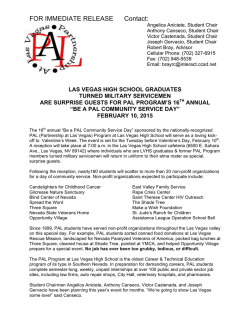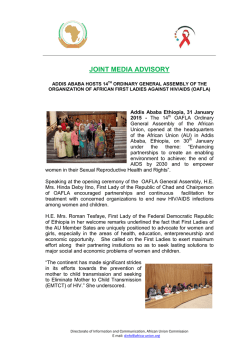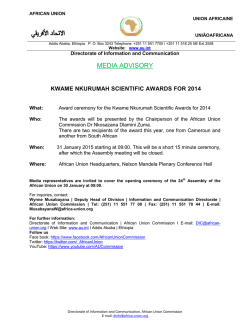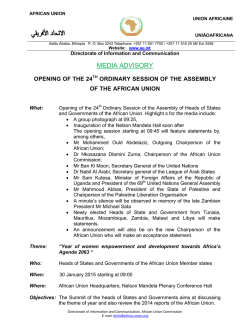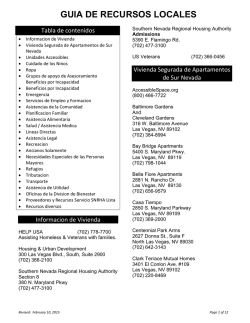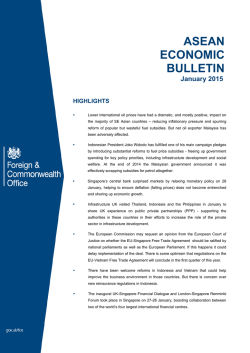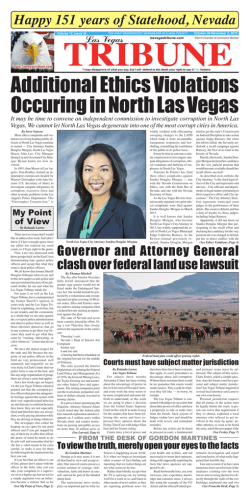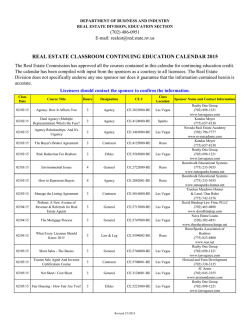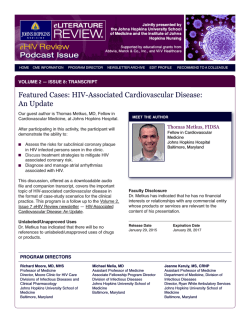
Economic and Social Council - Spring Valley High School Model
LVMUN II 2nd Annual Las Vegas Model UN Conference February 21, 2015 Topic Synopses: Economic and Social Council Dear Delegates, Hello delegates! My name is Una Karanovic, I am a senior and I will be one of your chairs for the Economic and Social Council (ECOSOC) at LVMUN II. This is my third year in MUN but my first time as a chair for this conference. In addition to participating in LVMUN I last year, I have also attended conferences in California and one international conference, PAMUN, in Paris, France. Next year I plan to attend college in New York, and I wish to continue participation in MUN while majoring in Biology. I look forward to meeting you all and hearing your ideas on conference day. My name is Ronald Hemphill, and I will be your co-chair for the Economic and Social Council (ECOSOC) at LVMUN II! I am a senior and this is my second year in Model United Nations for Spring Valley High School and my first year as one of the conference’s chairs. I’ve enjoyed going to MUN conferences for Spring Valley in these past 2 years. I am interested in going to New York for college majoring in international relations and business administration and also continuing my activity in Model UN on a college level. I cannot wait to hear all of your ideas pertaining to these two topics. Sincerely, Una Karanovic [email protected] Ronald Hemphill [email protected] LVMUN II 2nd Annual Las Vegas Model UN Conference February 21, 2015 Topic #1: Asia and the new Global Economy Background: The Association of Southeast Asian Nations, or ASEAN, is the world largest growing region in terms of economic growth. For the past seventy years this region has experienced high economic growth rates compared to the sluggish economies of the Western bloc. The U.S. and nations belonging to the European Union both rely on ASEAN nations, especially China, for manufacturing and cheap labor; however China increasingly does not rely on the West for investment. China and other ASEAN nations have begun to reduce trade to the West and have increased intra regional trading in order to protect the ASEAN economies from the global recession. To combat the slowing rates of investments, China has also begun to invest outwardly into developing nations. During this past decade the global economy has seen significant increase in trade between South America, Africa, the Middle East and East Asia. China has surpassed the U.S. and the EU as Africa's primary trade partner which means that the economic growth of many African nations increasingly relies on the stability and continued growth of China. This does not have to be a negative thing; the ASEAN bloc has enjoyed a generally healthy economy which can benefit the rest of the world. Japan, China, and South Korea, often called economic tigers, are role models for developing nations who hope to create sustainable growth and increase standards of living. The success of ASEAN therefore translates to success for the regions it trades with and can contribute to overall growth of the global economy. LVMUN II 2nd Annual Las Vegas Model UN Conference February 21, 2015 UN Action: With economic growth comes the growth of national debt and sometimes economic instability. Many ASEAN nations have miraculously continued economic growth for decades without being affected by global recessions. Other developed and developing nations alike have been affected by the global recession and have suffered instability, inflation, and extreme debt problems. This committee in part was created to help member states combat these issues by working cooperatively and strategically. The World Bank is an organization which was created to loan money to poor developing nations or nations in crisis; it has supported more than 12,000 projects in more than 170 countries since 1947. The International Monetary Fund also loans money to member nations, however its primary function requires that member nations allow their currency to be exchanged for foreign currencies freely. The work of both organizations has been incredibly important in improving the economies of individual nations and helping them achieve the UN Millennium Development Goals such as: eradicating poverty by half, reducing the national debt of developing nations, and increasing availability of education and information. The primary purposes of the IMF and The World Bank are to eradicate poverty which ties into all of the UN Millennium Goals. Creating sustainable growth for the global economy is imperative for tackling the Millennium Goals. LVMUN II 2nd Annual Las Vegas Model UN Conference February 21, 2015 Questions to consider: 1. Is your nation dependent on any of the ASEAN nations for trade or economic support, either directly or indirectly? 2. In what ways does investment into Asia improve (or negatively affect) the global economy overall? 3. What current economic trends in Asia might be considered potential threats or areas of concern to specific member states or to the global economy as a whole? 4. How does improving the global economy affect the Millennium Development Goals? 5. How do political events affect the health of the global economy; such as the western sanctions on Russia because of their role in the Ukrainian Crisis? 6. What are some ways that the UN can promote sustainable development in the global economy? (Consider the role of ECOSOC, the IMF, and the World Bank.) LVMUN II 2nd Annual Las Vegas Model UN Conference February 21, 2015 Works Cited Balisacan, Arsenio M., With, Sharon Faye Piza, and Dennis Mapa. Tackling Poverty and Social Impacts: Philippine Response to the Global Economic Crisis (n.d.): n. pag. Web. Cuenca, Janet, Celia Reyes, Josef Yap, "Impact of the Global Financial Crisis on the Philippines", May 20, 2011 "The IMF and the World Bank: How Do They Differ?" The IMF and the World Bank: How Do . They Differ? N.p., n.d. Web. 24 Nov. 2014. "Why Globalization Doesn't Need the West - Forum:Blog." ForumBlog. N.p., n.d. Web. 24 Nov. . 2014. "60 Ways the United Nations Makes a Difference." UN News Center. UN, n.d. Web. 24 Nov. 2014. LVMUN II 2nd Annual Las Vegas Model UN Conference February 21, 2015 Topic #2: Development in Africa Background: The continent of Africa is the second largest in the world and contains 30% of the world’s remaining mineral resources and over one billion people. Despite its vast size however, (Africa contains 85% of the world’s arable land) much of the continent’s land is unusable due to recurring natural disasters, lack of technology, and lack of agreement between African nations and a host of other challenges. Two of the most prominent issues that the continent faces are the spread of HIV/AIDS or other diseases and the scarcity of clean drinking water. HIV/AIDS has been one of the most prominent diseases in the African nations, affecting 23.5 million people as reported in 2011. Almost 40% of the people who do not have sufficient water in the world are located in Sub-Saharan Africa, leading to an increase in diseases, lessened agricultural capabilities, and higher rates of poverty as people living in the region are frequently focused on basic survival, such as acquiring clean drinking water, rather than to tending to jobs and education. These two issues need to be resolved in order to focus on developing Africa holistically and many independent foundations are attempting to achieve these goals. To complicate matters, there often exists a lack of sanitation systems in these areas, as modern plumbing is scarce in many areas of the African continent. LVMUN II 2nd Annual Las Vegas Model UN Conference February 21, 2015 UN Action: Purifying water and the prevention of diseases (including HIV/AIDS) have been two primary objectives of the United Nations since the creation of the Millennium Development Goals (MDGs) in 2000 at the Millennium Summit. Along with the goals to prevent the spread of HIV/AIDS and other diseases and to purify water for drinking are the goals to eradicate extreme poverty and hunger, achieve universal primary education, implement global gender equality, reduce child mortality, improve maternal health, and form global partnership for development. The MDGs were created with the African region in mind as numerous developing nations exist. The United Nations International Children’s Fund (UNICEF) has had initiatives to combat water scarcity such as promoting purification systems in African nations. African nations also continue to gain support from the International Monetary Fund (IMF) and the World Bank, amd both organizations actively monitor economic development in the region. Questions to Consider 1. What has your nation done to prevent the spread of major diseases and provide potable water? 2. How does your nation plan to assist African nations? 3. What kinds of programs and services can be implemented in the African nations to improve economic development? 4. What impact do the Millennium Development Goals currently have on Africa’s ability to sustain itself and ultimately grow? LVMUN II 2nd Annual Las Vegas Model UN Conference February 21, 2015 Works Cited "Africa." The World Bank. Web. 17 Nov. 2014. "Africa HIV & AIDS Statistics." HIV and AIDS Information and Resources. AVERT. Web. 23 Nov. 2014. "IMF Survey : Africa Enjoying Dynamic Growth but Challenges Remain." IMF Survey : Africa Enjoying Dynamic Growth but Challenges Remain. 20 Apr. 2013. Web. 25 Nov. 2014. "UN Millennium Project | About the MDGs." UN Millennium Project | About the MDGs. Web. 23 Nov. 2014. Hickman, Martin. "Water Hazard: How the UN Plans to Provide Clean Drinking Water for Everyone in Rwanda." The Independent. Independent Digital News and Media, 1 Sept. 2013. Web. 24 Nov. 2014. "Why Water - Access to Clean, Safe Water in Africa." The Water Project. Web. 21 Nov. 2014.
© Copyright 2026
